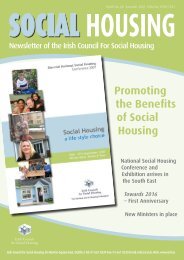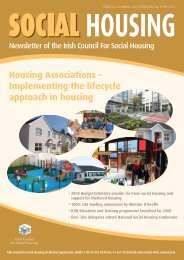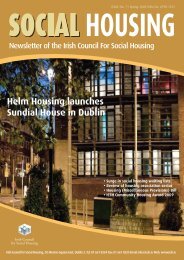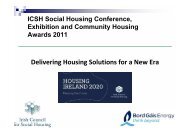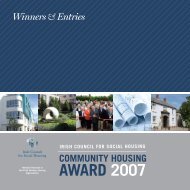National Housing Strategy for People with a Disability 2011 - 2016
National Housing Strategy for People with a Disability 2011 - 2016
National Housing Strategy for People with a Disability 2011 - 2016
You also want an ePaper? Increase the reach of your titles
YUMPU automatically turns print PDFs into web optimized ePapers that Google loves.
Appendix 10The Evolution of Residential Services <strong>for</strong> <strong>People</strong> <strong>with</strong> DisabilitiesExtract from Chapter 2 of the Report of the Working Group on CongregatedSettings, HSE, published 28 June <strong>2011</strong>2.1 THE EARLY DEVELOPMENT OF CONGREGATED PROVISIONResidential institutions <strong>for</strong> people <strong>with</strong> disabilities have a long history in Ireland. 15 In the18th century, workhouses, poorhouses and asylums accommodated people who were sick ordestitute and people <strong>with</strong> mental health problems. By the end of the 19th century, therewere 22 large residential institutions in Ireland, each <strong>with</strong> a catchment area of one or twocounties, where staff and residents lived, and where there was no interaction <strong>with</strong> the worldoutside the institution. During the 1850s, a focus on the special needs of people <strong>with</strong>intellectual disabilities developed. As a result of lobbying by prominent citizens, the firstinstitution <strong>for</strong> people <strong>with</strong> intellectual disabilities, the Stewart Institution, opened in 1869,<strong>with</strong> four teachers and a programme of instruction.More than 50 years passed be<strong>for</strong>e a second special residential institution was opened. In thelate 1920s, the Daughters of Charity agreed to turn an existing home <strong>for</strong> children into ahome and school <strong>for</strong> children <strong>with</strong> learning disabilities. Over the following 30 years, severalreligious orders opened special centres around the country. The development of specialcentres marked the start of a process of specialisation, and this approach was stronglyembedded in the 1960s, <strong>with</strong> the development of a range of new professions specialising intherapies and services <strong>for</strong> people <strong>with</strong> learning disabilities.2.2 DEVELOPMENTS IN THE 1950S AND 1960SThe 1950s saw the development of Parents and Friends Groups, a movement that grewstrongly in the 1960s, <strong>with</strong> the setting up of local groups in counties around Ireland and thedevelopment of services and facilities in communities. The Commission on Mental Handicap(1965) 16 recognised that care in the community was generally superior to and ‘moretherapeutic’ than institutional care. The 1970 Health Act and the development of communitycare services in the country’s health boards underpinned the emerging community‐basedapproach to service provision.2.3 DEVELOPMENTS SINCE THE 1980SThe Green Paper ‘Towards a Full Life’ (1984) recognised the slow growth in provision ofresidential services <strong>for</strong> people <strong>with</strong> physical disabilities. It noted that the majority of people<strong>with</strong> physical disabilities who could not live at home were maintained in county homes,psychiatric hospitals and orthopaedic hospitals, geriatric hospitals and centres <strong>for</strong> people<strong>with</strong> intellectual disabilities. 17 The review of accommodation carried out at that time foundthat few of the centres reviewed, apart from Cheshire Homes, were equipped to meet theneeds of people <strong>with</strong> physical disabilities:165165



